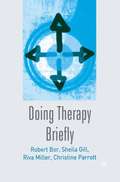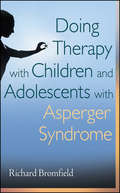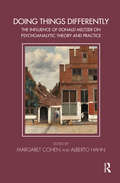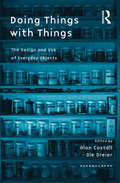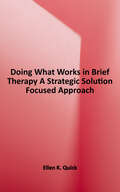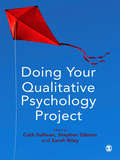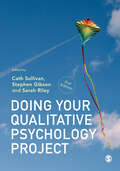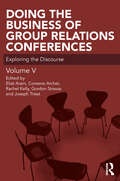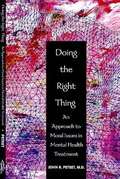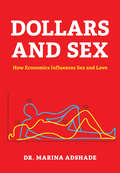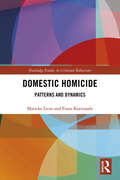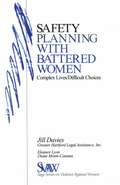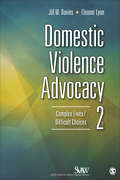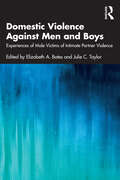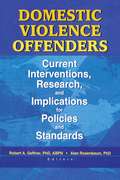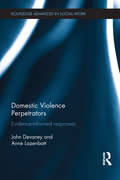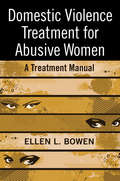- Table View
- List View
Doing Therapy Briefly
by Robert Bor Sheila Gill Riva Miller Christine ParrottWith lengthy waiting lists, reduced resources and demands for more clearly defined performance outcomes, more and more counsellors, psychotherapists and psychologists are finding themselves under pressure to provide short-term treatment for their patients. In this book the authors argue that to work briefly counsellors need not just use a diluted version of their usual longer-term therapeutic model. They suggest that to work briefly is to work differently and they present the basic principles underlying a new trans-theoretical model.
Doing Therapy with Children and Adolescents with Asperger Syndrome
by Richard BromfieldPraise for Doing Therapy with Children and Adolescents with Asperger Syndrome "Providing an explanation of Asperger's based on a review of scientific research, Richard Bromfield describes how the characteristics of the syndrome affect the person's thoughts and experiences throughout childhood. Psychotherapy based on the practices described in this book will change the destiny of children and adults with Asperger Syndrome to one of greater connectivity to themselves and others. This should become the primary text for pshchotherapists working with children and adolescents with Asperger's. " -Tony Attwood, PhD, author of The Complete Guide to Asperger's Syndrome "Dr. Blomfield generously shares his wisdom and experience in this very accessible, honest, and often moving book. Any clinician who reads it in its entirely-or even selects a chapter or two at random-will no doubt discover new paths to take their most complex and challenging clients and gain a greater appreciation for those with Asperger Syndrome. Bromfield gives us all a window into a world that is hard to describe, impossible to imagine, but needs and deserves to be understood. " -Naomi Angoff Chedd, LMHC, Autism Specialist and coauthor of Replays Cutting-edge guidance for effective treatment of children and adolescents with Asperger Syndrome Diagnoses of Asperger Syndrome in children and adolescents are on the rise, and while some clinicians have training and experience in this area, most do not. Using vivid case material, Doing Therapy with Children and Adolescent with Asperger Syndrome offers clinicians the guidance they need to treat the young people they endeavor to help.
Doing Things Differently: The Influence of Donald Meltzer on Psychoanalytic Theory and Practice (Tavistock Clinic Series)
by Margaret CohenDoing Things Differently celebrates the work of Donald Meltzer, who was such a lively force in the training of child psychotherapists at the Tavistock Clinic for many years. The book represents the harvest of Meltzer's thinking and teaching, and covers such topics as dimensionality in primitive states of mind, dreaming, supervision, and the claustrum.
Doing Things with Things: The Design and Use of Everyday Objects (Ethnoscapes)
by Ole DreierIt has been claimed that the natural sciences have abstracted for themselves a 'material world' set apart from human concerns, and social sciences, in their turn, constructed 'a world of actors devoid of things'. While a subject such as archaeology, by its very nature, takes objects into account, other disciplines, such as psychology, emphasize internal mental structures and other non-material issues. This book brings together a team of contributors from across the social sciences who have been taking 'things' more seriously to examine how people relate to objects. The contributors focus on every day objects and how these objects enter into our activities over the course of time. Using a combination of different theoretical approaches, including actor network theory, ecological psychology, cognitive linguistics and science and technology studies, the book argues against the standard notion of objects and their properties as inert and meaningless and argues for the need to understand the relations between people and objects in terms of process and change.
Doing What Works in Brief Therapy: A Strategic Solution Focused Approach
by Ellen K. QuickThis book is both a set of procedures for the therapist and a philosophy- one that is shared with clients and one that guides the work of the therapist. This second edition continues its excellence in offering clinicians a guide to doing what works in brief therapy- for whom, when, and how to use it. Psychotherapy that follows these guidelines validates the client's most important concerns - and it often turns out to be surprisingly brief. Author, Ellen Quick integrates strategic and solution focused therapy and includes guidelines for tailoring technique and interventions to client characteristics and preferences. With clinically rich examples throughout, this book offers applications for couples, including indications for individual or conjoint sessions.
Doing Your Qualitative Psychology Project
by Sarah C.E. Riley Dr Stephen Gibson Cath SullivanThis book is for students who are embarking on a qualitative research project in psychology or a related discipline. While focusing mainly on undergraduate dissertations, this book will also be useful for postgraduate students. It takes you through planning a qualitative project, stage by stage, addressing key issues and concerns along the way. The focus throughout is on how to make your project excellent!<P><P> Packed full of examples from student projects to help you to put theory into practice, the book guides you through:<P> * designing your research<P> * ethical considerations<P> * collecting your data<P> * analysing your data<P> * writing your report or dissertation. <P> In addition, the book will help you with time management and working with your supervisor, as well as providing guidance on how you can use your project as the basis for publication or further study.
Doing Your Qualitative Psychology Project
by Cath Sullivan Stephen Gibson Sarah RileyEmbarking on your own psychology research? This book equips you with the skills you need to complete a qualitative project confidently. The book takes you through the process of doing your project, showing how to plan and execute each stage. It helps you make good decisions about key steps such as choosing a research topic, designing your project, doing ethical research and writing up. This second edition: Offers a host of learning features including ‘in a nutshell’ summaries, further reading, activities and top tips to help you develop your understanding and skills. Devotes more space to the important topics of project planning and doing ethical research with a new chapter on each. Enables you to critically evaluate your work, helping you conduct high-quality research. Discusses student success stories and cautionary tales illustrating, from start to finish, how qualitative projects are done in the real world. This is the perfect guide for undergraduates doing a final project or dissertation, and postgraduates who are relatively new to qualitative research.
Doing Your Qualitative Psychology Project
by Cath Sullivan Stephen Gibson Sarah RileyEmbarking on your own psychology research? This book equips you with the skills you need to complete a qualitative project confidently. The book takes you through the process of doing your project, showing how to plan and execute each stage. It helps you make good decisions about key steps such as choosing a research topic, designing your project, doing ethical research and writing up. This second edition: Offers a host of learning features including ‘in a nutshell’ summaries, further reading, activities and top tips to help you develop your understanding and skills. Devotes more space to the important topics of project planning and doing ethical research with a new chapter on each. Enables you to critically evaluate your work, helping you conduct high-quality research. Discusses student success stories and cautionary tales illustrating, from start to finish, how qualitative projects are done in the real world. This is the perfect guide for undergraduates doing a final project or dissertation, and postgraduates who are relatively new to qualitative research.
Doing it
by Isadora AlmanWe all have questions about sex that we still haven't found answers to. No matter how much girl-chat or guy-talk we engage in, there are some topics left untouched and questions left unanswered. Now, go behind the doors of bedrooms across the country and read the naked truth about sex and relationships that readers of nationally syndicated sex columnist Isadora Alman have shared over the years. Doing It draws from discussions on Alman's popular web site and from written responses to her column, offering thoughts, experiences, stories, and advice on all topics sexual. Organized by the natural progression of relationships and inclusive of all gender preferences, areas discussed include the singles scene, dating, intercourse, voyeurism, lubricants, libido, STDs, and creative sexual positions.
Doing the Business of Group Relations Conferences: Exploring the Discourse (The Group Relations Conferences Series)
by Rachel Kelly Eliat Aram Coreen Archer Gordon Strauss Joseph TriestGroup Relations conferences offer opportunities to learn about group, organisational and social dynamics; the exercise of authority and power; the interplay between tradition, innovation and change; and the relationship of organisations to their social, political and economic environments. This book, the fifth in a series of Tavistock Group Relations Conferences, contains a collection of papers presented at the fifth Belgirate conference, plus three additional papers reflecting on and making sense of several participants’ conference experiences. Taken together, these chapters study the discourse of Group Relations conferences as well as reflecting on the changing nature and shifting patterns of this discourse. In Doing the Business of Group Relations Conferences, authors reflect on the vicissitudes of meanings this expression generates.
Doing the Right Thing: An Approach to Moral Issues in Mental Health Treatment
by John R. Peteet<p>Here is the first practical guide for dealing with the moral issues that regularly confront clinicians in their work. Written for all mental health professionals, Doing the Right Thing: An Approach to Moral Issues in Mental Health Treatment offers a framework both for making moral decisions concerning the treatment of patients and for helping patients deal with their own moral concerns. <p>Drawing on current thinking in several disciplines, Doing the Right Thing introduces the concept of moral functioning as a basis for therapeutic influence. Numerous case examples illustrate how to * Assess patients' ability to function morally -- Learn how six basic capacities needed for moral functioning develop, and how identifying problems in an individual's moral functioning can help guide the formulation of a treatment plan.* Treat patients with problems functioning morally -- Appreciate when it is time to set aside neutrality as a therapeutic stance in favor of a more direct approach to helping patients make moral commitments, decisions and self-assessments and develop moral character.* Deal with the moral aspects of clinical decision-making -- Develop a framework for making moral choices in planning the direction of treatment, confronting resistance and addressing problems in caring effectively. * Help patients address moral challenges -- Learn how to take into account your own and the patient's values in reasoning through moral dilemmas. Understand more clearly how to help patients deal with unfair pain caused by others, as well as the guilt and shame caused by their own moral failures.* Employ the therapeutic potential of moral growth, transformation, and integration -- Discover the role of a clinician in helping demoralized patients reformulate their ideals for better outcomes. Recognize where a moral paradigm is useful in improving the delivery of mental health care. <p>Concise, clear, and clinically relevant, Doing the Right Thing is a valuable, thought-provoking guide for both new and seasoned mental health practitioners who live and work in a morally complex environment. It is also an excellent supplementary text for courses dealing with the practice of psychotherapy and the ethical aspects of mental health care.</p>
Dollars and Sex: How Economics Influences Sex and Love
by Marina AdshadeLike Freakonomics, Dollars and Sex takes economics and converts it into a sexy science by applying the principles of supply and demand, and other market forces, to matters of love, courtship, sex, and marriage. As she does in her hugely popular blog, author Marina Adshade explores the marketplace for sex and love using research, economic analysis, and humor to reveal just how central the interplay of libido, gender, love, power, and economic forces is to the most important choices we make in our lives. Call it "Sexonomics."
Dolls, Photography and the Late Lacan: Doubles Beyond the Uncanny
by Rosalinda QuintieriIn this fascinating new book, Rosalinda Quintieri addresses some of the key questions of visual theory concerning our unending fascination with simulacra by evaluating the recent return of the life-size doll in European and American visual culture. Through a focus on the contemporary photographic and cinematic forms of this figure and a critical mobilisation of its anthropological complexity, this book offers a new critical understanding of this classical aesthetic motif as a way to explore the relevance that doubling, fantasy and simulation hold in our contemporary culture. Quintieri explores the figure of the inanimate human double as an "inhuman partner", reflecting on contemporary visuality as the field of a hypermodern, post-Oedipal aesthetic. Through a series of case studies that blur traditional boundaries between practices (photography, performance, sculpture, painting, documentary) and between genres (comedy, drama, fairy tale), Quintieri puts in contrast the new function of the double and its plays of simulations on the background of the capitalist injunction to enjoy. Engaging with new theories on post-Oedipal forms of subjectivity developed within the Lacanian orientation of psychoanalysis, Quintieri offers exciting analyses of still and moving photographic work, giving body to an original aesthetic model that promises to revitalise our understanding of contemporary photography and visual culture. It will appeal to psychoanalysts and researchers from Lacanian psychoanalysis, visual studies and cultural theory, as well as readers with an academic interest in the cultural history of dolls and the theory of the uncanny.
Dolor crónico: Procedimiento de evaluación e intervención psicológica
by Jordi Miró MartínezEl dolor es un tema de especial relevancia. Su misma existencia resulta un reto para los profesionales de la salud, no en vano es la principal causa de búsqueda de atención médica y sanitaria. El estudio y tratamiento del dolor se ha convertido en un campo de encuentro de profesionales de disciplinas científicas diversas. En este libro se analizan las aportaciones de la Psicología y la situación actual de su relación con el dolor crónico. Se trata de presentar e instruir al lector interesado sobre los procedimientos de evaluación y técnicas de intervención que existen y de sus resultados, así como de detallar las bases teóricas que los sustentan. El autor ofrece una guía para la evaluación y el tratamiento de los problemas de dolor crónico, y plantea y responde a cuestiones de importancia para el futuro del área.
Dolphin Cognition and Behavior: A Comparative Approach (Comparative Cognition and Neuroscience Series)
by Ronald J. Schusterman, Jeanette A. Thomas and Forrest G. WoodPublished in 1986, Dolphin Cognition and Behavior is a valuable contribution to the field of Cognitive Psychology.
Dolphin Communication and Cognition: Past, Present, and Future (The\mit Press Ser.)
by Christine M. Johnson Denise L. HerzingExperts survey the latest research on dolphin communication and cognition, offering a comprehensive reference to findings in the laboratory and from the field.Dolphin researchers have collected an impressive amount of data over the last twenty years, thanks to advances in technology for monitoring, recording, and analyzing dolphin behavior as well as increasing interest in exploring and modeling dolphins' cognitive capacities. This volume offers a comprehensive reference to the latest research on dolphin communication and cognition, reporting on findings from both the laboratory and the field. The contributors review a wide range of topics, including vocalization, abstract reasoning abilities, imitation and learning, social cognition, echolocation, and ethical issues in working with cetaceans.The book begins by examining the dolphin brain and its evolution, the anatomy of its unique sound production and reception systems, and its sensory abilities. It next treats communication, reviewing the complexity of dolphins' vocalization, and then describes research on cognition, from both experimental and developmental perspectives. Finally, the book considers the future of dolphin research, including a series of provocative questions that remain unanswered, posed by the volume's expert contributors.ContributorsMats Amundin, Whitlow Au, Ted W. Cranford, Nicola Erdsack, John Ford, Wolf Hanke, Louis M. Herman, Denise L. Herzing, Christine M. Johnson, Petr Krysl, Stan Kuczaj, Marc Lammers, Lori Marino, Paul Nachtigall, Julie Oswald, Adam A. Pack, Heidi Pearson, Sam Ridgway, Jeanette Thomas, Randall Wells, Thomas I. White, Hal Whitehead, Kelley Winship, Bernd Würsig
Domestic Animals and Leisure: Rights, Welfare, And Wellbeing (Leisure Studies in a Global Era)
by Neil CarrThis volume offers both an insight into the current state of research on domestic animals in leisure and a lens through which to begin to chart the future of research in this field. All of the contributions to the collection are underpinned by ongoing debates about human-animal relationships and the rights and welfare of the latter.
Domestic Demons and the Intimate Uncanny (Routledge Studies in Religion)
by Thomas G. Kirsch Rijk Van Dijk Kirsten MahlkeThis book explores local cultural discourses and practices relating to manifestations and experiences of the demonic, the spectral and the uncanny, probing into their effects on people’s domestic and intimate spheres of life. The chapters examine the uncanny in a cross-cultural manner, involving empirically rich case studies from sub-Saharan Africa, Latin America and Europe. They use an interdisciplinary and comparative approach to show how people are affected by their intimate interactions with spiritual beings. While several chapters focus on the tensions between public and private spheres that emerge in the context of spiritual encounters, others explore what kind of relationships between humans and demonic entities are imagined to exist and in what ways these imaginations can be interpreted as a commentary on people’s concerns and social realities. Offering a critical look at a form of spiritual experience that often lacks academic examination, this book will be of great use to scholars of Religious Studies who are interested in the occult and paranormal, as well as academics working in Anthropology, Sociology, African Studies, Latin American Studies, Gender Studies and Transcultural Psychology.
Domestic Homicide: Patterns and Dynamics (Routledge Studies in Criminal Behaviour)
by Marieke Liem Frans KoenraadtThe literature on domestic violence will often treat homicide as its most extreme outcome. The reality is more nuanced, with many domestic homicides occurring within a history of abusive behaviour. This book offers a much-needed synthesis of the literature on domestic homicide, covering its history; the theories supporting it; its various forms such as filicide, intimate partner homicide, parricide, siblicide and familicide; and its prevention. The authors explore the predominant theories that have been used to explain domestic homicides in general, as well as specific subtypes of domestic homicide. Each chapter then takes a chronological approach in examining relationships between victim and perpetrator in the most prominent types of domestic homicide. Drawing on the empirical evidence, it offers a unique insight into the dynamics of domestic homicides, and debunks some of the common stereotypes surrounding it. The book concludes with an overview of the main areas of prevention of domestic homicide and offers recommendations for professionals working in domestic violence services, medical practitioners and mental health services. This book will be of interest to criminologists, psychiatrists, psychologists and sociologists alike, and will be key reading for a range of courses on violence, abuse and aggression.
Domestic Violence Advocacy: Complex Lives/Difficult Choices
by Dr Jill Davies Eleanor J. LyonDomestic Violence Advocacy: Complex Lives/Difficult Choices, Second Edition is a comprehensive and highly practical resource for anyone working with domestic violence victims. The essential elements and values of the victim-defined approach provide the foundation for a completely revised exploration of all victims’ perspectives and advocates’ roles. Authors Jill Davies and Eleanor Lyon draw on the far-reaching progress and increased knowledge of the field and delve deeply into the experiences of victims, their perspectives and decision-making, culture, and risks. Attentive to the real- world context of limited time, resources, and options for victims and for advocates, this enlightening text focuses on what is feasible and offers ideas for working within such constraints.
Domestic Violence Advocacy: Complex Lives/Difficult Choices (SAGE Series on Violence against Women #7)
by Dr Jill Davies Eleanor J. LyonDomestic Violence Advocacy: Complex Lives/Difficult Choices, Second Edition is a comprehensive and highly practical resource for anyone working with domestic violence victims. The essential elements and values of the victim-defined approach provide the foundation for a completely revised exploration of all victims’ perspectives and advocates’ roles. Authors Jill Davies and Eleanor Lyon draw on the far-reaching progress and increased knowledge of the field and delve deeply into the experiences of victims, their perspectives and decision-making, culture, and risks. Attentive to the real- world context of limited time, resources, and options for victims and for advocates, this enlightening text focuses on what is feasible and offers ideas for working within such constraints.
Domestic Violence Against Men and Boys: Experiences of Male Victims of Intimate Partner Violence
by Elizabeth A. Bates Julie C. TaylorDomestic Violence Against Men and Boys: Experiences of Male Victims of Intimate Partner Violence is a unique book that brings together contemporary research and practice around working with men and boys who are victims of domestic violence and abuse. The book features contributions from experts within the field who draw on the wide range of evidence that demonstrates the multifarious experiences and impacts of this victimisation. This text focusses on the increasing evidence related to the prevalence of domestic violence and abuse within the family towards men and boys. With contributions from experts within the field, this book covers a comprehensive list of topics derived from empirical evidence. The chapters focus on key themes, such as, experience of the abuse; challenges to the current theory; barriers and experiences of help-seeking; impact on children, and working with male victims within practice and criminal justice settings. Further, the text underscores numerous recommendations around changing current practices to enable a better support system for men and boys. The text will therefore be invaluable in increasing awareness of the research and support in the field of domestic violence. This book will be of use to researchers, practitioners and educators working in the field of domestic violence and abuse. It will also be beneficial to policy makers who are reviewing legislation and those involved in commissioning psychological services, and victim services that work with male victims.
Domestic Violence Offenders: Current Interventions, Research, and Implications for Policies and Standards
by Alan RosenbaumWomen’s shelters and safe houses were a good first step, but they only address part of the problem. Learn what else must be done to address the problem of domestic violence! Domestic Violence Offenders presents recent research, current interventions, and legal standards for people arrested for domestic violence. It also addresses the controversies that have arisen in the wake of the mandatory standards for batterer interventions that have been established by various jurisdictions, examining the type of treatment modality and content permitted by various jurisdictions, the duration of treatment, and the relationship of the various standards to actual research. This essential book also provides suggestions for a more inclusive, less rigid process for creating standards and policies for use with this population. Handy tables and charts make the information easily accessible. From the editors: “The initial societal response to intimate partner violence was the development of the shelter movement for battered women. Women&’s shelters and/or safe houses developed in almost all major population areas throughout the United States and abroad. The goals were to provide a safe environment for abused women and their children, to offer advocacy, counseling, and medical services, and to empower women to leave their abusers. While shelters continue to serve these and other critical needs and are an essential part of the service delivery system for battered women, they address only part of the problem. Left untreated, batterers often will continue to abuse their partners who leave shelters and return to the relationship. If their partners leave the relationship, the batterers may find new victims to abuse. The response to this harsh reality was the development of batterer intervention programs.” Domestic Violence Offenders provides you with informed discussions of: the implications of research and policies for those providing interventions why it is premature for states to establish certain rigid standards for batterer programs, and how some of the current standards may produce more harm than good the history of batterer intervention programs completion and recidivism among court- and self-referred batterers the Alternatives to Violence program and the experiences and perceptions of its founder common aspects of various intervention programs—confidentiality, group structure and length, partner contacts, leadership configuration, and program goals topics addressed by most programs—power and control, anger management, substance abuse, stress reduction, parenting, communication, and more the controversial and often misunderstood issue of female partner aggression and violence the Stages of Change approach to domestic violence treatment lethality assessment and safety planning for partners of batterers the advantages of conjoint therapy for certain types of cases the Illinois Protocol for batterer programs outcome research on programs for batterers and a great deal more!
Domestic Violence Perpetrators: Evidence-Informed Responses (Routledge Advances in Social Work)
by Anne Lazenbatt John DevaneyDomestic violence is a serious, widespread public, social and health problem that affects the lives of many women, children and men. There is also evidence to suggest it has one of the highest rates of recidivism. This comprehensive book provides an overview of what the research tells us about the perpetrators of domestic violence and what works, and what doesn’t, in promoting positive change. Collecting together the most up-to-date evidence from the international literature and bringing psychological, sociological, gendered and socio-political theoretical perspectives to bear on the issue, the authors explore: - what domestic violence is, why it happens and how it can be measured - who the perpetrators of domestic violence are, including discussion of non-stereotypical patterns such as male victims, female perpetrators, couples where the abuse is mutual, and couples with abusive relationships who want the abuse to end but the relationship to be sustained - strategies for engaging perpetrators in interventions and for promoting behaviour change - evidence-informed interventions, programmes and policies for working with perpetrators - where robust evidence is lacking and more research needs to be undertaken. Domestic violence is a significant problem for those individuals and families whose life is affected by this issue, the social, health and criminal justice agencies that respond to it, and wider society which must bear the costs and its devastating effects. This volume is an important reference for all those researching and working with the victims, survivors and perpetrators of domestic violence, including academics and students from fields such as social work, sociology, criminology, psychology and social policy.
Domestic Violence Treatment for Abusive Women: A Treatment Manual
by Ellen L. BowenMost therapists have experience with wives, girlfriends, and children of violent men, never suspecting that domestic violence offenders can be women too. In Domestic Violence Treatment for Abusive Women, Bowen challenges us to re-think our gender and violence constructs and guides clinicians through the emerging field of treatment of female abusers. Unlike other books designed for male clients that may be adapted to women, this book is specifically written for use with women, with handouts and exercises created from the author’s own clinical experience. It is deliberately designed to give clinicians knowledge to deal with all aspects of female domestic violence, from dealing with their first client to filling out paperwork correctly. The first part of the book is dedicated to defining female violence and helping readers overcome pre-existing gender stereotypes. The second part provides a framework for everything a therapist needs in order to set up and facilitate a domestic violence treatment program for women. As a whole, Domestic Violence Treatment for Abusive Women helps the licensed mental health professional understand women’s domestic violence and offers step-by-step direction for successful therapy.
